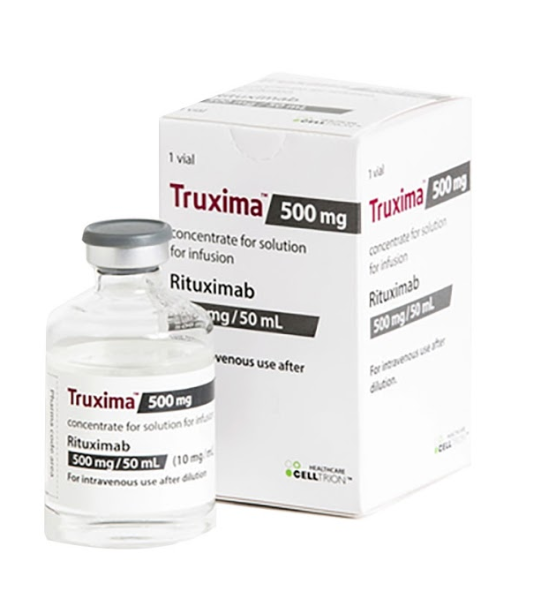Truxima (rituximab) vs Vanflyta (quizartinib)
Truxima (rituximab) vs Vanflyta (quizartinib)
Truxima (rituximab) is a monoclonal antibody used to treat certain types of blood cancers, such as non-Hodgkin lymphoma and chronic lymphocytic leukemia, as well as autoimmune diseases like rheumatoid arthritis. Vanflyta (quizartinib) is a tyrosine kinase inhibitor specifically indicated for the treatment of adults with relapsed or refractory acute myeloid leukemia (AML) with FLT3-ITD mutations, a specific genetic alteration. When deciding between these medications, it is crucial to consider the specific type and genetic characteristics of the cancer, as Truxima and Vanflyta are used for different conditions and work through distinct mechanisms of action.
Difference between Truxima and Vanflyta
| Metric | Truxima (rituximab) | Vanflyta (quizartinib) |
|---|---|---|
| Generic name | Rituximab | Quizartinib |
| Indications | Non-Hodgkin's lymphoma, chronic lymphocytic leukemia, rheumatoid arthritis, granulomatosis with polyangiitis, and microscopic polyangiitis | Relapsed or refractory acute myeloid leukemia with FLT3-ITD mutation |
| Mechanism of action | CD20-directed cytolytic antibody | Tyrosine kinase inhibitor |
| Brand names | Truxima, Rituxan, MabThera | Vanflyta |
| Administrative route | Intravenous infusion | Oral |
| Side effects | Infusion reactions, fever, lymphopenia, chills, infection, and asthenia | QT prolongation, nausea, thrombocytopenia, musculoskeletal pain, and anemia |
| Contraindications | Hypersensitivity to rituximab or other murine proteins | Hypersensitivity to quizartinib or any component of the formulation |
| Drug class | Monoclonal antibody | Tyrosine kinase inhibitor |
| Manufacturer | Celltrion Healthcare, Genentech | Daiichi Sankyo |
Efficacy
Truxima (Rituximab) Efficacy in Leukemia
Truxima, a biosimilar to the original rituximab, is a monoclonal antibody that targets the CD20 antigen found on the surface of B cells. It is used in the treatment of non-Hodgkin lymphoma, a type of leukemia. Clinical trials have demonstrated that when combined with chemotherapy, rituximab can improve survival rates in patients with certain types of non-Hodgkin lymphoma, including follicular lymphoma and diffuse large B-cell lymphoma. Specifically, rituximab has been shown to induce remission, prolong progression-free survival, and in some cases, improve overall survival when used as a first-line treatment or as maintenance therapy following initial remission.
While Truxima is not indicated for all types of leukemia, its efficacy in B-cell non-Hodgkin lymphomas, which are a group of leukemias, has been well established. The addition of rituximab to chemotherapy regimens has become a standard of care in the treatment of these diseases, reflecting its significant impact on patient outcomes. However, the efficacy of Truxima in other forms of leukemia, such as acute lymphoblastic leukemia (ALL) or chronic lymphocytic leukemia (CLL), may vary and is often evaluated on a case-by-case basis.
Vanflyta (Quizartinib) Efficacy in Leukemia
Vanflyta, the brand name for quizartinib, is a tyrosine kinase inhibitor that specifically targets FLT3-ITD (internal tandem duplication), a common mutation found in acute myeloid leukemia (AML). Quizartinib has shown efficacy in clinical trials for patients with relapsed or refractory AML with the FLT3-ITD mutation. In these studies, quizartinib has been associated with an increased rate of complete remission and has demonstrated a survival benefit compared to chemotherapy. The drug's ability to target the FLT3-ITD mutation makes it a valuable option for a subset of AML patients who harbor this specific genetic alteration.
It is important to note that the efficacy of Vanflyta is particularly relevant to AML patients with the FLT3-ITD mutation. For these patients, the mutation-specific action of quizartinib can be a critical component of their treatment regimen. However, the efficacy of Vanflyta in other forms of leukemia or in AML patients without the FLT3-ITD mutation has not been established. Therefore, the use of Vanflyta is tailored to the genetic profile of the leukemia, emphasizing the importance of molecular diagnostics in the management of the disease.
Regulatory Agency Approvals
Truxima
-
European Medical Agency (EMA), European Union

-
Food and Drug Administration (FDA), USA

-
Health Canada

-
Therapeutic Goods Administration (TGA), Australia

-
Medsafe (NZ)

Vanflyta
-
European Medical Agency (EMA), European Union

-
Food and Drug Administration (FDA), USA

Access Truxima or Vanflyta today
If Truxima or Vanflyta are not approved or available in your country (e.g. due to supply issues), you can access them via Everyone.org.
How it works

Make an enquiry
Choose the medicine you want to buy, answer a couple of questions, and upload your prescription to speed things up. We’ll get back to you within 24 hours.


Make an enquiry
Choose the medicine you want to buy, answer a couple of questions, and upload your prescription to speed things up. We’ll get back to you within 24 hours.


Breeze through the paperwork
We'll guide you through the required documents for importing unapproved medicine, ensuring you have all the necessary information.


Get a personalized quote
We’ll prepare a quote for you, including medicine costs and any shipping, administrative, or import fees that may apply.


Receive your medicine
Accept the quote and we’ll handle the rest - sourcing and safely delivering your medicine.

Some text on this page has been automatically generated. Speak to your physician before you start a new treatment or medication.
Let's talk
If you have any questions, call us or send us a message through WhatsApp or email:
Contact us




